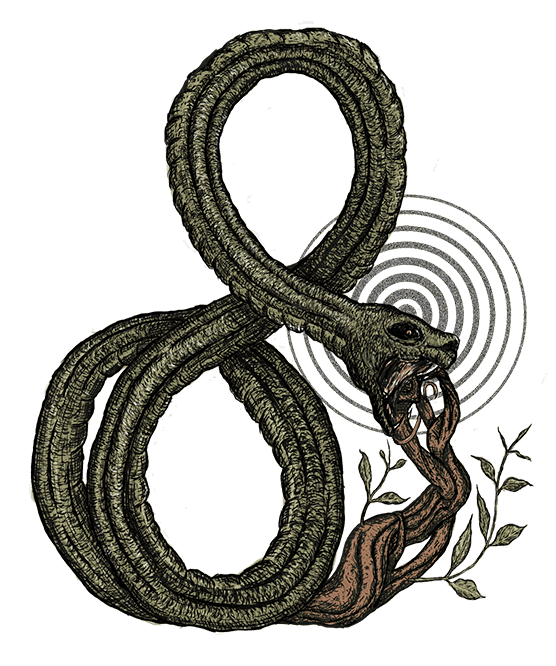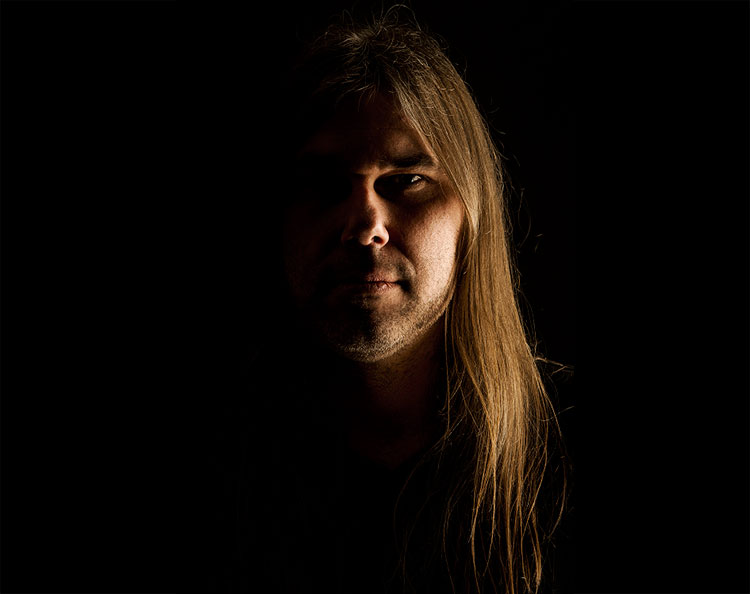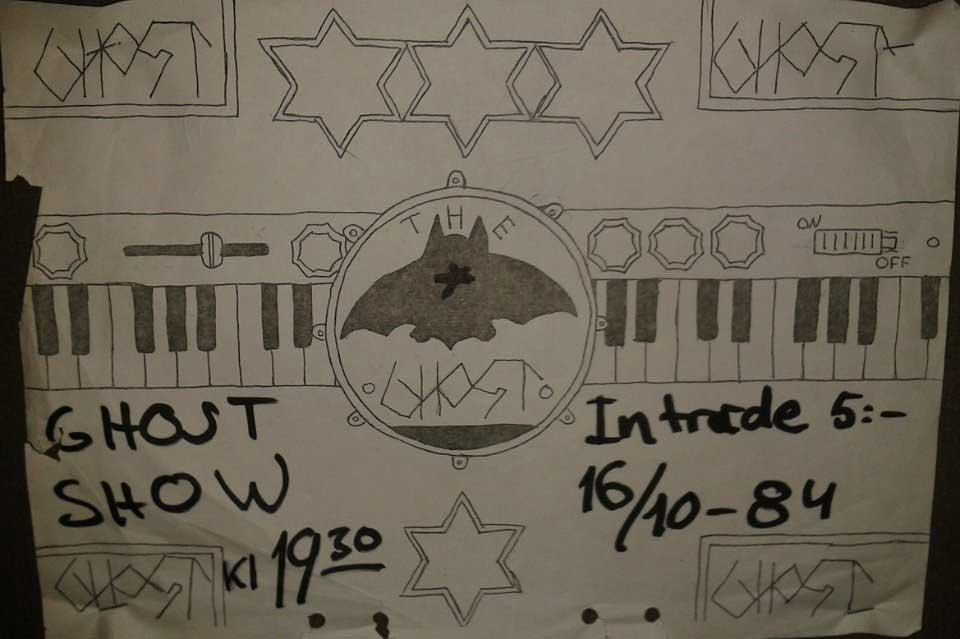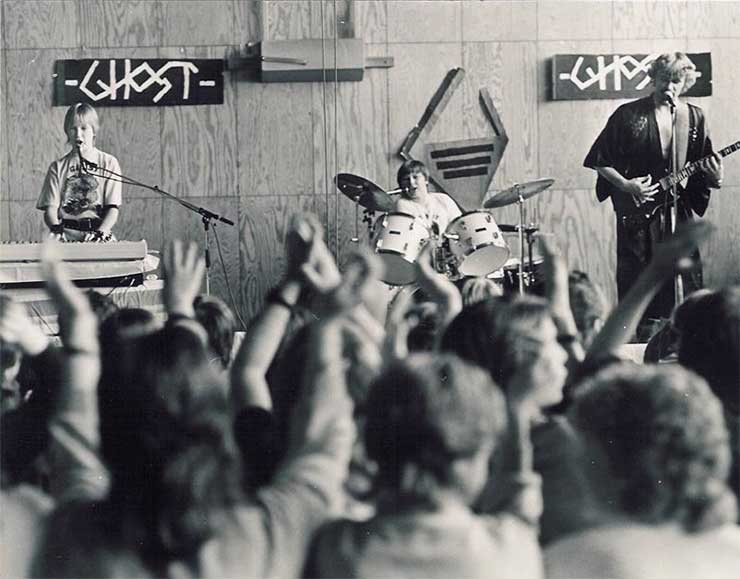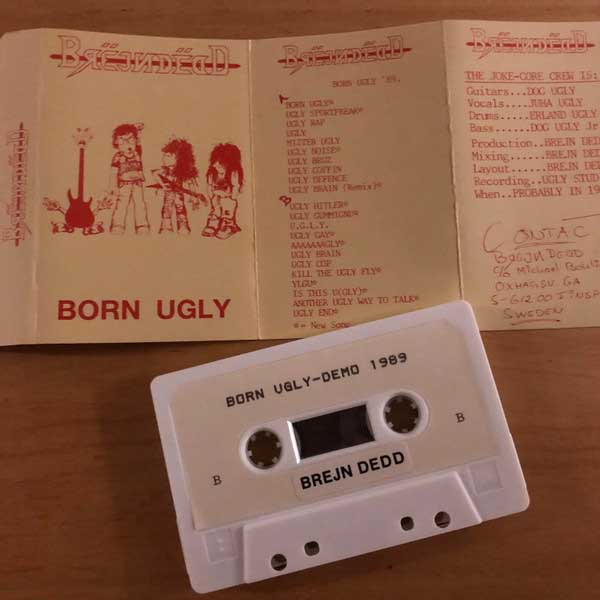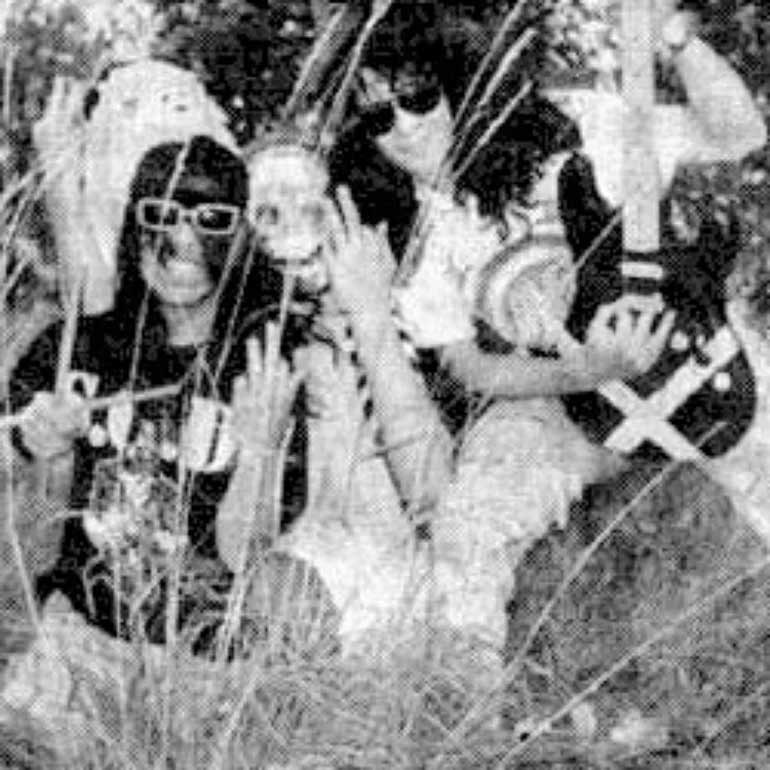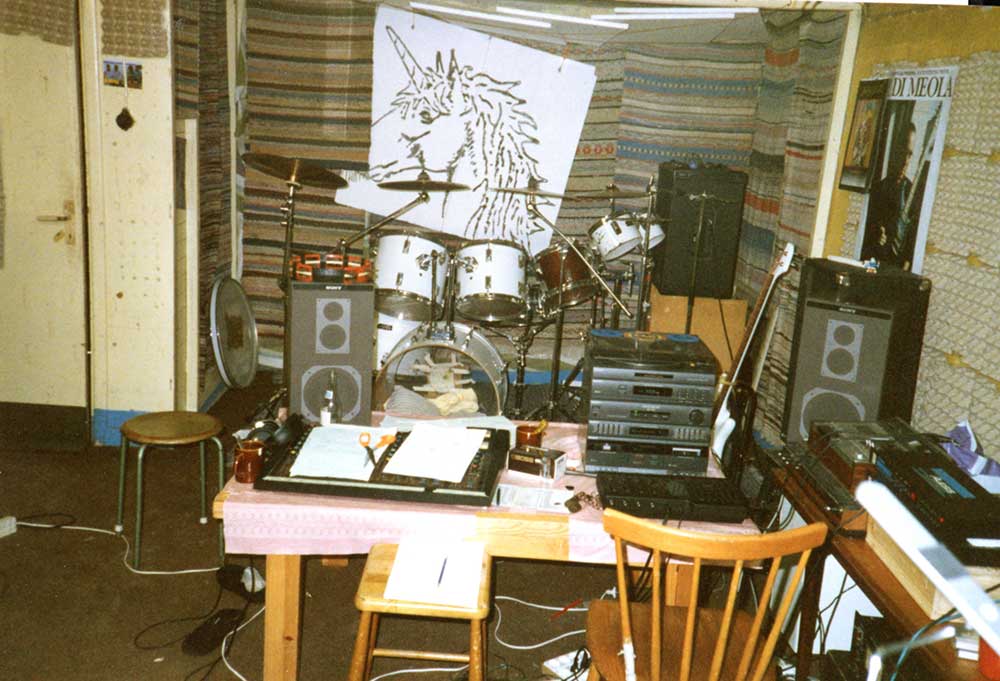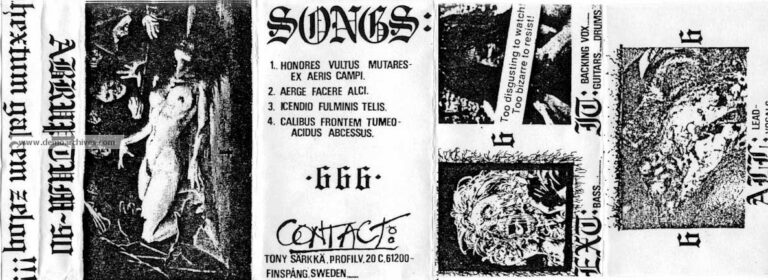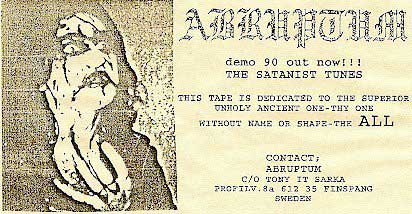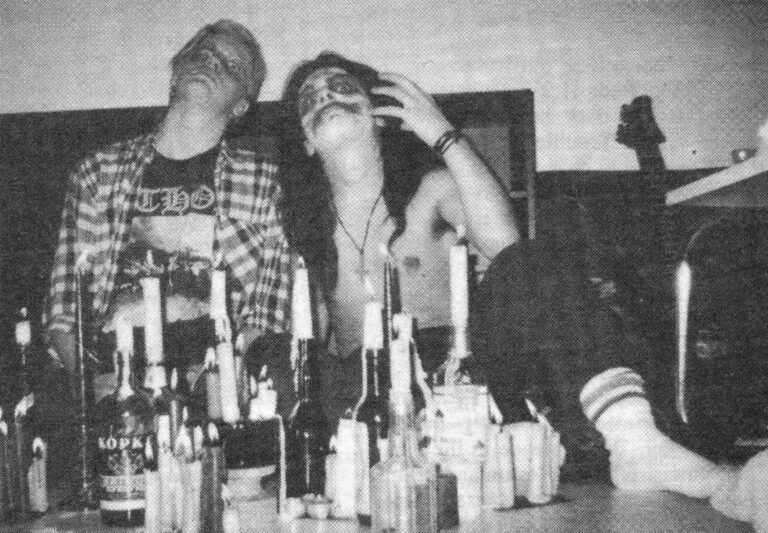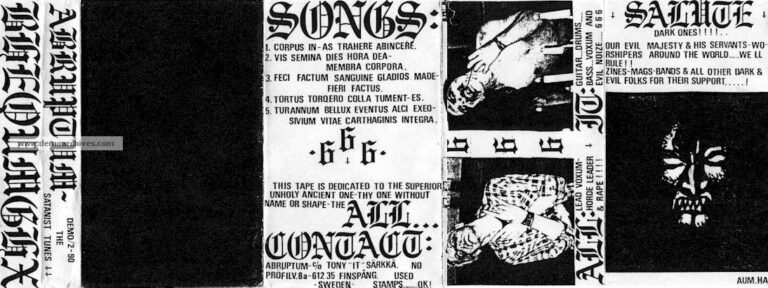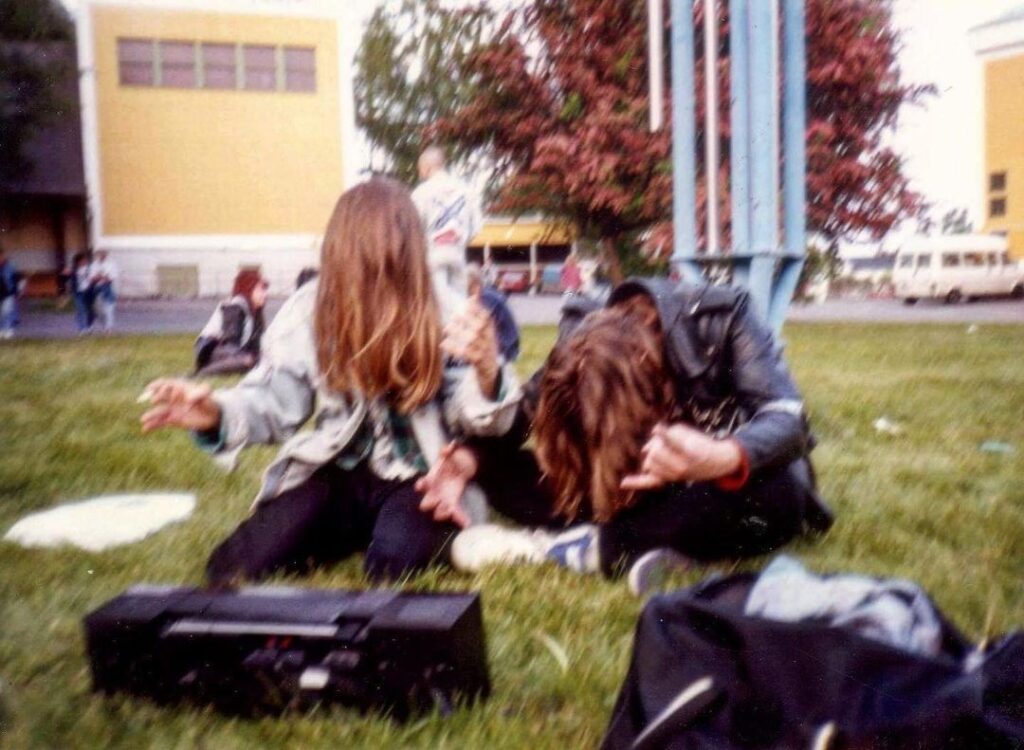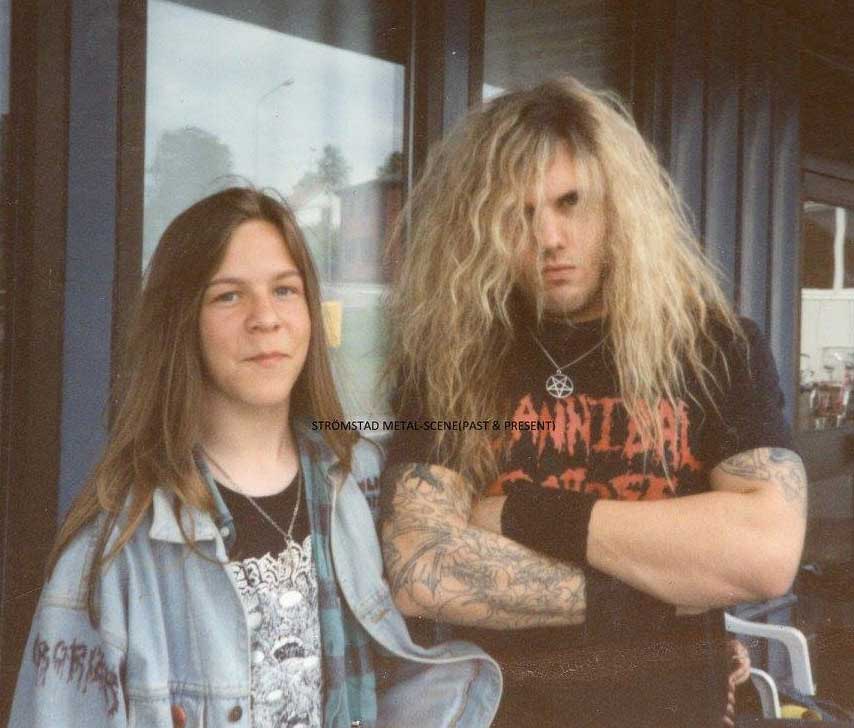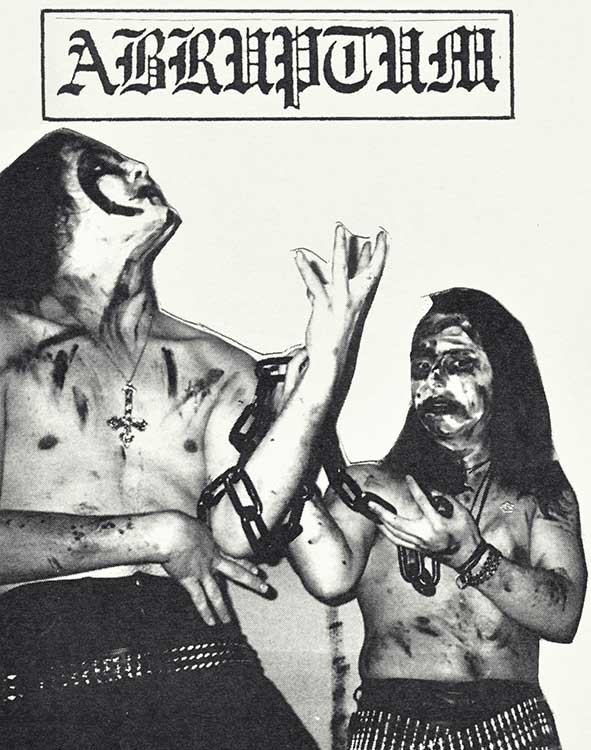Dan Swanö I
2024-01-03
by Niklas Göransson
Within the hallowed halls of Unisound, Dan Swanö etched his legacy into 90s black metal history. Our nostalgic journey through the early Swedish scene begins with an examination of the seminal soundscapes that shaped bands like Abruptum and Marduk.
DAN SWANÖ: I have a memory from way back in middle school of Tony and me sitting next to each other on the playground. Both of us stood out. He was already into the dark side of metal, whereas I – a JUDAS PRIEST fanatic – walked around with studded bracelets and leather pants, trying to look like Rob Halford. That’s how Tony and I first got to talking.
Dan Swanö and Tony Särkkä – more known by his alter ego, IT – grew up in Finspång in the Östergötland province of Sweden.
SWANÖ: He was a huge VENOM fan, but the hardest stuff I listened to would’ve been MERCYFUL FATE. Sure, they had an evil image and so on but were rather tame in a musical sense. As we got to know each other, Tony mentioned his band, WITCHES SABBATH, and I told him about GHOST.
GHOST was a hard rock band founded by ten-year-old Dan Swanö in 1983. The same year, Tony Särkää formed WITCHES SABBATH.
SWANÖ: Tony thought we were dorks for singing in Swedish, despite our lyrics being quite dark. I mean, we had titles that turned up in black metal over a decade later: “Nattens härskare” (‘Ruler of the Night’), “Demonernas intrång” (‘Incursion of the Demons’), “Midnatt” (‘Midnight’), and so on. WITCHES SABBATH sang in English and had a song called “Son of Satan”, which I found supremely heavy. I saw them live once at a youth club and thought, ‘Fuck, that’s actually pretty evil.’
By the time they reached junior high, Tony was barely ever in class.
SWANÖ: He’d mostly hang out in the recreation room, throwing snus at the ceiling and trying to dropkick people – without much success, given his minute stature. We had a kind of love-hate relationship during those years because Tony always saw himself as far cooler than me. Most of our early interactions consisted of him ridiculing GHOST while I tried to defend myself.
In 1988, Dan and his friend Micke Bohlin – who was going out with Tony’s sister – formed a thrash metal band called BREJN DEDD. Dan wasn’t really into such music but thought playing at higher speeds might improve his technique as a rock drummer.
SWANÖ: Micke proposed that we bring in Tony on vocals. I still remember my initial reaction: ‘No way! He’s a problem child who drinks and smokes and has a generally shitty attitude.’ But I was overruled, and the three of us started spending a lot of time in the rehearsal room. It was there somewhere that we really started connecting.
How was he as a bandmate?
SWANÖ: The way Tony’s brain worked… he was dead serious about everything he did. He wasn’t at all like me, a projects guy. When he joined BREJN DEDD, it was a matter of life and death. BREJN DEDD was a side-project to me – but for Tony, it meant the absolute world. I had already gone through a phase like that with GHOST, which was on its way to becoming ICARUS, so I found it a bit annoying.
By the time GHOST morphed into ICARUS, their musical lodestars had shifted from KISS to GENESIS and similar progressive rock bands. But as Dan immersed himself in heavier and darker metal while learning how to play thrash, his musical horizons involuntarily expanded.
SWANÖ: Tony essentially indoctrinated me into listening to all these evil bands. Somewhere around ’89, we started ordering LPs from Svenska skivklubben. Only records with the most extreme promo texts – ‘speed metal”, ‘full throttle’, and so on. We got along much better, but I was a bit intimidated or even outright scared of him at times. He could be very direct and had his moody periods. If he’d broken up with some girl, he wanted to go out into the forest and kill himself. Everything was always completely black or white, without a semblance of contrast.
Nonetheless, once the pair had cast off their protective layers and built up some mutual trust, they bonded as friends do.
SWANÖ: Tony could also be warm and humorous, but I don’t know how many got to see that side of him. He taught me a lot. We were extremely different, so it was a bit of an ‘opposites attract’ kind of scenario. Of course, with his upbringing… hmm, I’m not sure how much of this I can talk about publicly.
In an interview for Blood, Fire, Death: The Swedish Metal Story by Ika Johannesson, Tony stated that he never met his real father; instead, his mother married a violent alcoholic. He describes a childhood plagued by domestic abuse and similar trauma, which left him with deep emotional scars. He had a hard time relating to others and never felt part of humanity – hence why he took the name IT.
SWANÖ: Oh, alright. Well, each time his stepdad – the father of his younger half-brother – was out on prison leave, they had to go into hiding because he wanted to murder them. Tony’s mother moved him and his siblings around a lot, so they always lived in new places. Mostly different apartment buildings on a street called Profilvägen. ‘Where do you live now?’ ‘11C’. Next time, ‘17B’. All this sounded completely surreal; I think the worst thing that happened to me growing up was being called ‘chubby’ or something. Tony’s childhood was totally bizarre.
Did he talk about it much?
SWANÖ: No, barely a word. But of course, I’d still hear things once in a while. Tony would also have the occasional blowout; I remember once when we were out on some island, partying, and he’d mixed paracetamol with alcohol. He flipped out completely, in a way that someone only does a few times during his lifetime. He went totally out of his mind and wanted to kill us all. Four people had to pin him to the ground – which wasn’t too difficult.
Tony Särkää was very short – around 155 centimetres, or 5 foot 1.
SWANÖ: Despite the occasional meltdown, I must say that we collaborated well and made some killer stuff together – just the two of us. We had a mutual musical respect. Not to mention BREJN DEDD, which eventually became very important to me. Without it, you and I wouldn’t be having this conversation today.
Once Dan had dipped his feet into the Swedish metal underground, he started taking a serious interest in the emerging phenomenon – only to then go completely mental.
SWANÖ: I have a somewhat manic part of my personality. When I discover something new, I’m essentially all in for an intense period during which I explore everything about it. So, when I got into this thrash thing, I attended pretty much every show within driving distance. If there was a Tuesday-night gig at Nya Strömmen in Norrköping – with bands like MEZZROW plus local support – I’d be there, no question about it. Front row, headbanging; the whole thing. I’d also hang out at local record shops like Spiralen, or in the corridor of the building where Robban Becirovic and Erik Sandberg recorded Power Hour.
Power Hour was a metal radio show founded in 1987. Over the years, it grew to become tremendously important for metalheads in the entire region. While broadcast from Norrköping, it would also reach nearby Finspång and Linköping.
SWANÖ: Sometimes, I’d lend them my records. Say, if I’d been to Spiralen and bought five Bay Area thrash albums, it wasn’t certain that Robban had received them from the label yet. He’d go, ‘Oh wow, the new FAITH OR FEAR’, ‘The new TOXIK’, or whatever. ‘Can we play it on the show?’ As you can imagine, that was the coolest shit imaginable: someone spinning my LP on the radio. We just sat there in the corridor – it was unbelievably exciting knowing that a metal show aired on the other side of the wall. And that’s how I met Morgan.
Morgan Håkansson was a fellow underground fanatic around the same age as Dan. He attended the same gigs, so they’d seen each other around.
SWANÖ: He mentioned playing in a band… I think it was called ANTROPOMORAFAS or something like that. I’ve never really figured out if they actually existed. I had BREJN DEDD and… I don’t know, EDGE OF SANITY? I think we’d formed by then. Morgan and I started hanging out, and he came along on all the road trips we did.
Where to?
SWANÖ: Festivals like Bergslagsrocken, various gigs in Fagersta and Stockholm, as well as all the Thrash Bash fests in Linköping and Norrköping. I myself organised a few shows in Finspång.
At this point – after no more than a few months as ICARUS – what started as GHOST had become UNICORN. To record their 1988 demo, “A Collection of Worlds, Part I”, they bought a portable cassette four-tracker. Once proficient with the new equipment, Dan started offering his services to other bands.
SWANÖ: The first UNICORN recordings were labelled as Spam Studio, but bands could call it whatever they liked. Basically, it was just our rehearsal spot with a porta-studio inside. The first four-tracker we had was a Yamaha – solid stuff, with DBX.
DBX noise reduction was a significant advancement in the analogue era, reducing the persistent issue of tape hiss and other interference.
SWANÖ: After a while, we discovered that this ‘stereo’ thing can actually be pretty useful. At first, I recorded the drums on channel one, bass on two, guitar on three, and vocals on four. I always avoided ping-ponging to the greatest possible extent, for which I am eternally grateful. That’s why it’s been possible for me to remix many of the recordings I made back then.
Ping-ponging is an analogue recording method where one merges – or ‘bounces’ – several tracks into one, thus freeing up channels for additional layers. The downside is that once this has been done, one cannot make any changes to the volume, sound, or panning of the individual instruments.
SWANÖ: After working with the four-tracker for a while, I bought another one just like it. We started tracking drums on channels one and two, and guitars on three and four – both in stereo. Then I’d bounce the two tracks with the same instrument into two channels on the other porta, also in stereo. That’s how I eventually found this bigger and wider sound, which began rearing its head somewhere around the GOREMENT demo.
The first incarnation of this extremely simple setup was called Gorysound. Swedish death metal band GOREMENT recorded their first demo, “Human Relic”, there.
SWANÖ: That was one of many… let’s call it six-channel recordings. And many of them sound better than my later works on reel-to-reel. I was a bit confused then. Everything on the Yamaha sounded fantastic from the get-go: the instruments were more separated. The eight-channel came with a mixing desk filled with strange buttons that I had no clue what they did. The porta offered bass and treble adjustments, and that’s pretty much all I had to worry about. But it was often enough.
Building on his audio engineering skills, Dan started experimenting with various soundscape ideas he’d been toying with.
SWANÖ: When music was truly dark, it would give me this really cool feeling – similar to when I watched horror movies. Scary but exhilarating. So, when I’d hear dark music pieces such as certain parts on “Sad Wings of Destiny” and “Sin after Sin” by JUDAS PRIEST, or the first DUST album, I’d get a tingling sensation. Like, ‘Wow, unreal!’ That’s why the early GHOST recordings had this haunting and foreboding atmosphere with lots of minor scales, even if we weren’t fully able to convey it using mostly organs, drums, and a tender boy’s voice.
For those interested in further exploration of GHOST, Bone Records released a compilation called “1983 – 1988” in 2018. Considering the ages of the musicians involved, it is truly impressive.
SWANÖ: Honestly, I’ve sometimes wondered why it took me so long to get sucked into the whole speed, black, and thrash metal wave. Instead, I kept doing my own stuff. But I was always so fucking disappointed when I finally got to hear these evil acts I’d seen in magazines. I would stare at photos of bands like WASP – surrounded by blood and bones, beheading topless ladies on stage – and get this sense that it should sound as if it had been recorded amidst sulphur and hellfire. I expected torrents of malevolence to come pouring out of my speakers, but the music turned out to be regular metal.
What about VENOM?
SWANÖ: Not really; they were like a rawer and noisier version of MOTÖRHEAD. None of it really clicked with me, and I’d always end up feeling let down. ‘Why doesn’t anything ever sound like I envision it?’ I suspect it was around here that I started immersing myself in reverb and things of such nature.
This initiative coincided with the birth of Tony’s new project, ABRUPTUM. The self-titled demo was recorded at Gorysound and then released in February 1990.
SWANÖ: I wanted ABRUPTUM to sound like these illustrations of Hell that used to be really popular as metal covers: caverns filled with fire and evil and sinners being tortured. That’s how the music I know as ‘black metal’ is supposed to sound! I connected our porta to the Alesis Microverb II, essentially slamming the reverb fully, and then further into a mixing desk. And that’s when it dawned on me. ‘Now, this sounds fucking evil.’
The Alesis Microverb came out when digital reverb was still transitioning from being a luxury of high-end studios to a more widely available tool. Known for its straightforward interface and ease of use, it enabled musicians and amateur engineers to add the depth of reverb to their sound.
SWANÖ: However, such a production means you can’t really do much with the actual song, as it risks turning into one big echoing cacophony. The music needs space to breathe, which is why ABRUPTUM was tailor-made for this. They had their patented, droning drumbeat and struck about one chord per hour. And then a lot of screaming on top. It was perfect.
The music sounds like a strange mix of proto-black metal and death industrial, with a production that gives it a truly eerie quality.
SWANÖ: Very few people have heard ABRUPTUM without reverb. I have – and let me tell you, it’s not all that exciting. But once we found that sound… fucking hell, it was insanity. The music took on a completely different feel and became almost cinematic in some sense. And I thought, ‘At last, we have arrived.’ From this point on, I started appreciating productions infused with that type of horror ambience.
ABRUPTUM – which also featured vocalist All – expanded on this style when they recorded their second demo, “The Satanist Tunes”, later the same year.
SWANÖ: Listening to those demos would transport you from your living room to another place; it was like entering a satanic church. I’ve always appreciated that kind of atmosphere, but it vanished as soon as records started sounding too good. I think it was a big part of what became ABRUPTUM’s sound. They wanted it to be as evil as possible: I suppose you could say it was a match made in Hell.
Did you know the vocalist, All?
SWANÖ: No, but we went to the same school. At first, he was just some normal, pale guy. I’d seen him around, but then – overnight – he turned evil and joined Tony’s sect. I found that a bit confusing. Then again, I’m sure people were surprised when I suddenly became some kind of death metal icon. I suppose they couldn’t quite envisage an AOR guy with a huge perm morphing into something like that, but these things do happen.
The 1990 edition of a one-day festival called Bergslagsrocken became a milestone event in many ways. Not only for hosting the Swedish debut of both MORBID ANGEL and PESTILENCE, but it also facilitated many contacts that proved highly formative for the domestic metal scene.
On June 2, 1990 – the same week ENTOMBED’s “Left Hand Path” was released – many underground devotees who had only corresponded through writing or over the phone met in person for the first time. Morgan Håkansson and Jon Nödtveidt were one such example: they had been exchanging letters for some time, and Morgan assisted Jon with his ‘zine, Mega Mag.
SWANÖ: Bergslagsrocken is where I met Jon for the first time, too. I have this vivid memory of him sitting on the grass, blasting death metal from a boombox. Back then, it was like, ‘Look, someone is listening to death metal. I’d better go over and introduce myself.’ It was a given – you were mates, even if you didn’t know each other. Death metal wasn’t super-common.
The year before, Jon Nödtveidt had started DISSECTION with his childhood friends Peter Palmdahl and Ole Öhman, who were also his bandmates in a thrash band called SIREN’S YELL.
SWANÖ: We listened to an early demo version of DISSECTION’s “Severed into Shreds”. He played it non-stop, all the while headbanging. We exchanged contact details and became pen pals. He had already released Mega Mag #1 by then, I believe, or if it was just about to be finished. There was some talk about EDGE OF SANITY being featured in the second issue; I think we’d released the “Kur-Nu-Gi-A” demo by then.
By 1991, after two demos and a seven-inch EP, All had been ousted from ABRUPTUM. He was replaced by Evil (Morgan Håkansson), who took on guitar duties, while IT (Tony) handled vocals. Dan helped them record “De Profundis Mors Vas Consumet” – a track that would later appear on Necropolis Records’ “Nordic Metal: A Tribute to Euronymous” compilation.
log in to keep reading
The second half of this article is reserved for subscribers of the Bardo Methodology online archive. To keep reading, sign up or log in below.
